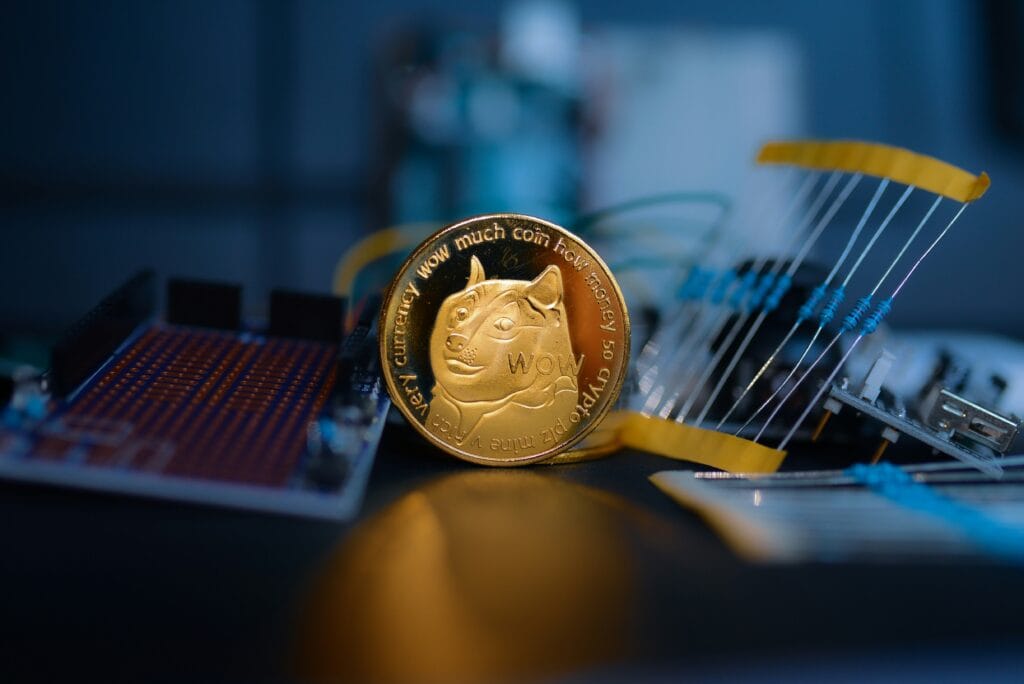Is Meme Coin fake ?
By expert

Meme coins are typically cryptocurrencies that are created more for fun or as a joke, rather than for serious use or investment. They often gain popularity through social media and online communities, and their value can sometimes skyrocket due to hype or viral trends, even though they don’t usually have strong underlying technology or use cases.
The most famous example is Dogecoin, which started as a meme but became widely known and gained value over time, though it’s still considered a meme coin at its core. While meme coins are not necessarily “fake,” they are often highly speculative and volatile, meaning they can be risky investments.
Here’s a bit more detail on meme coins:
1. Origin and Purpose:
- Meme coins often start as a joke or meme within online communities. They typically have no significant technological innovation or serious utility behind them.
- Some coins, like Dogecoin, started as a parody of Bitcoin, using the famous “Doge” meme (the Shiba Inu dog with funny captions). Initially, they were created just for fun.
2. Popularity and Community:
- Meme coins thrive on community support. Their value can skyrocket through viral marketing, celebrity endorsements (like Elon Musk’s tweets about Dogecoin), or just sheer enthusiasm within internet forums like Reddit, Twitter, or Discord.
- For example, Shiba Inu (often called the “Dogecoin killer”) became popular largely due to community-driven hype, and it saw massive price swings fueled by excitement rather than any solid use case.
3. Volatility and Risk:
- Meme coins are extremely volatile. Their prices can change drastically within hours or even minutes. For example, a meme coin might jump in value after a viral tweet but then lose most of that value as hype dies down.
- Many meme coins lack any real-world utility or product development, meaning their value is largely speculative and based on market sentiment.
- Since they often lack robust development teams or long-term plans, meme coins are considered high-risk investments. Many people have lost money when the hype fizzled out.
4. Lack of Regulation:
- Like many cryptocurrencies, meme coins aren’t regulated by any government body. This makes them susceptible to pump-and-dump schemes, where groups artificially inflate the price to sell off their holdings and leave other investors stuck with worthless coins.
- This lack of regulation also means that some meme coins could be outright scams, where the creators have no intention of providing any real value.
5. Examples of Meme Coins:
- Dogecoin (DOGE): The original meme coin that has gained mainstream attention. It still has a community-driven focus and is used for tipping and charitable donations in some spaces.
- Shiba Inu (SHIB): Inspired by Dogecoin, Shiba Inu gained popularity in 2021 and has been marketed as a serious competitor to Dogecoin, but it’s still largely driven by speculation and community support.
- SafeMoon: Another meme coin that attracted attention due to its tokenomics, which promised rewards for holding the coin. While it’s not strictly a meme coin in the traditional sense, it gained popularity due to hype and viral trends.
6. Long-Term Viability:
- Sustainability is uncertain. Meme coins often lack a roadmap for long-term growth or adoption. Without meaningful use cases, they’re unlikely to sustain long-term value. Some might fade into obscurity when the hype ends.
- That said, if a meme coin builds a strong community or finds practical use cases (like Dogecoin, which is now accepted by some businesses), it could survive and grow. However, for most meme coins, the future is unclear, and the odds of long-term success are slim.
7. How to Approach Meme Coins:
- Be cautious: Meme coins can be fun to track and watch, but investing in them should come with caution. It’s not wise to invest large amounts of money into them unless you’re prepared to lose it.
- Do research: Always check the background of the project and the people behind it. Many meme coins are created with little to no real intention beyond making money from hype.
- Know your limits: Set limits on how much you’re willing to risk. Meme coins can be profitable, but they can also be disastrous if you’re not careful.
In short, while meme coins are not “fake” in the sense that they exist as digital assets, they are often speculative, highly volatile, and driven more by trends than any solid underlying technology. Keep a critical eye on them!
Does Meme Coin have future ?
The future of meme coins is uncertain, but there are a few factors that could influence their potential longevity. Here’s a breakdown of both the positive and negative aspects that will shape the future of meme coins:
Reasons Meme Coins Could Have a Future:
- Community Power and Hype:
- Meme coins often thrive on strong communities. If these communities stay active, engaged, and passionate, they can sustain the popularity of a meme coin for a long time. Dogecoin is a great example of this, where the community has supported the coin even though it has limited technological innovation.
- Memes are culturally relevant and spread quickly, especially when associated with popular culture or celebrity endorsements (like Elon Musk tweeting about Dogecoin). If meme coins continue to have widespread cultural relevance, they might continue to survive.
- Brand Recognition:
- Some meme coins, especially Dogecoin and Shiba Inu, have gained significant brand recognition. Dogecoin, in particular, is widely known and has even been used for charity events, tipping, and by some merchants as a form of payment. As they become more recognized, there might be more demand or practical use cases.
- Adoption and Utility:
- While many meme coins are not built with utility in mind, Shiba Inu is an example of a meme coin trying to expand into decentralized finance (DeFi) with its own ecosystem (ShibaSwap) and projects. If meme coins can build real-world use cases, like payment systems, decentralized apps, or NFTs, they might have more staying power.
- Dogecoin is also being accepted more widely as a payment method, thanks to its low transaction fees and community support. If meme coins can position themselves for niche use cases or partner with businesses, it could add value.
- Innovation and Development:
- Meme coins could evolve into something more than just jokes if the development teams behind them push for real technological advancements. For example, if they introduce better scalability, lower fees, or unique features, they could stand the test of time.
- Dogecoin started with little innovation, but it is evolving, with proposals like improvements to speed and security gaining attention. If meme coins continue to innovate and address real-world issues, they could carve out a lasting niche.
Challenges Facing Meme Coins’ Future:
- Speculation and Volatility:
- Meme coins are often driven by speculation, not solid fundamentals. This means that they can be extremely volatile, making it hard to predict if they’ll have lasting value. If the hype fades or the community loses interest, their value can drop drastically, leaving investors with losses.
- Because meme coins don’t typically have strong use cases or technological innovation, they’re highly dependent on market trends and short-term enthusiasm. If the next big trend shifts away from meme coins, they could lose their appeal.
- Lack of Serious Use Cases:
- For meme coins to truly have long-term viability, they need real-world utility. Most meme coins have limited practical applications beyond being used for speculative trading or as a novelty.
- If meme coins don’t evolve to offer something valuable beyond being a “fun” asset, they might eventually get overshadowed by more serious cryptocurrencies like Bitcoin, Ethereum, or newer projects with real-world use cases.
- Risk of Scams and “Pump-and-Dump” Schemes:
- Many meme coins are created quickly without much thought given to security or long-term development. There’s also the risk of “pump-and-dump” schemes, where individuals or groups artificially inflate the price of a meme coin and then sell off their holdings, leaving other investors stuck with a worthless asset.
- Without adequate regulation and scrutiny, meme coins are susceptible to fraud, and many people might get burned in the process. This could diminish their reputation over time, making investors wary.
- Market Sentiment Shifts:
- The value of meme coins is often linked to market sentiment and social media trends, meaning that their popularity can rise and fall based on what’s trending at any given moment.
- If there’s a shift in market interest away from meme coins, or if people begin to view them more skeptically, they could struggle to maintain relevance.
Possible Outcomes:
- Survival of the Fittest:
- It’s possible that only a few meme coins will endure long-term. Coins like Dogecoin and Shiba Inu have established large communities, so they may remain in the market for years to come, albeit at fluctuating values.
- Some meme coins may transition into more serious projects, developing real use cases and utility that give them lasting value.
- Fading into Obscurity:
- Many meme coins are likely to disappear over time. Without a strong foundation, they could lose value as attention shifts elsewhere. It’s common for people to jump on the next big trend, leaving previous meme coins behind.
- Evolution into Broader Ecosystems:
- If meme coins manage to develop useful features (DeFi, NFTs, partnerships), they could become part of larger crypto ecosystems, providing more than just speculative trading opportunities.
- For example, Shiba Inu is trying to build a broader ecosystem, and Dogecoin may be used in more practical ways in the future, potentially solidifying their place in the crypto world.
Conclusion:
While meme coins have a future potential, their longevity largely depends on their ability to adapt and find meaningful use cases. As long as they remain reliant on hype and speculative trading, they will continue to face challenges. However, with a strong community, continued innovation, and development, certain meme coins could survive and thrive in the long run.
If you’re thinking about investing in meme coins, it’s essential to stay informed and approach with caution, understanding the risks involved.
Is Meme Coin profitable ?
Meme coins can be profitable, but they are highly speculative and risky investments. These coins often gain popularity due to social media trends, influencers, or internet communities like Reddit or Twitter, rather than any real technological innovation or utility behind the coin itself.
Some investors have made significant profits from meme coins, such as Dogecoin or Shiba Inu, particularly during hype cycles. However, there’s a flip side: because meme coins are driven by speculation and social trends, their value can drop just as quickly as it rises. In many cases, once the hype dies down, these coins can lose a large portion of their value.
If you’re considering investing in meme coins, it’s crucial to be aware of the volatility and risk. Here are a few things to keep in mind:
- Short-term volatility: Meme coins can experience wild price swings in a short period, making them more suited to short-term traders who can handle the risks.
- Lack of utility: Many meme coins don’t have a clear, long-term use case or innovation behind them, so their value is largely based on speculation.
- Market Sentiment: Meme coins are often driven by social sentiment, so they can go up or down depending on news, trends, or celebrity endorsements.
In summary, meme coins have the potential for short-term profits but come with high risk. It’s essential to do thorough research and only invest what you’re willing to lose.

Leave a Reply